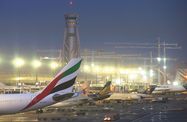Rising demand for freight handling, logistics and subsidiary services, along with an expansion into leisure, is driving growth in Dubai’s maritime sector, helping the emirate cement its position as a global leader in the industry.

Much of the increase in maritime trade and logistics has been driven by Dubai’s largest ports and logistics company, government-backed DP World, which posted a strong jump in freight handling in 2017.
DP World’s international network of terminals handled 70.1m standard twenty-foot equivalent units (TEUs) of containers last year, according to company data, a 10.1% increase on 2016.
Handling activity in its home market of the UAE grew by 4% to 15.4m TEUs, a strong result given the recent uncertainty in the region, Sultan Ahmed bin Sulayem, group chairman and CEO, said upon the release of the data in February.
Performance in the company’s global network was also positive: the Americas and Australia segment grew by 13.8%; its Europe, Middle East and Africa operations expanded by 11.5%; while its Asia-Pacific and Indian subcontinent terminals posted a 7.9% increase, shifting 31,900 units, more than 40% of the group’s total throughput.
Indian investments key to boosting international trade
With Asia-Pacific and the subcontinent representing such a large share of the state-owned shipping giant’s traffic, the emirate is seeking to strengthen its ties with India – one of the fastest-growing markets for international trade – by investing in logistics infrastructure in the country.
In mid-February the government of Dubai signed a memorandum of understanding with DP World and the regional government of Jammu and Kashmir in India to jointly explore the potential development of a multi-modal logistics hub and park in Jammu, including facilities for the transfer of containers, bulk cargo and break-bulk cargo.
The agreement follows the $1.2bn invested by DP World during the expansion of the Nhava Sheva Gateway Terminal at Mumbai’s Jawaharlal Nehru Port, which began in 2014.
“India is one of our major partners with vast economic potential,” Bin Sulayem told OBG in a recent interview. “We are also seeking opportunities worth over $1bn that would cover ports and associated logistics, inland container depots and expansion of existing intermodal rail services for rolling stock.”
The developments dovetail an increase in bilateral trade between India and the broader UAE, which rose by 10.6% in FY 2016/17 to reach $52.6bn, and is targeted to reach $100bn by 2020.
Of the seven countries tracked by international logistics company DHL’s monthly Global Trade Barometer – which together comprise more than 75% of the world’s trade – India scored the highest on overall trade growth forecasts, as well as in the areas of air and maritime trade, registering an acceleration in all three categories for the third consecutive month.
In terms of ocean trade, improved prospects were driven by contributions from all the industries tracked by the index, ranging from chemicals and products, to machinery parts and high-tech goods, suggesting Dubai-based manufacturers and traders could target a wide array of segments.
Efforts to strengthen trade ties will be facilitated by a February agreement between India and the UAE to conduct transactions directly in each other’s currencies, eliminating the need to use US dollars as an intermediary currency, saving time and transaction fees.
Leisure segment central to maritime diversification
While Dubai has a strong presence in the logistics and trade segments of the maritime industry, efforts are being made to diversify into other areas to solidify its position in the global market.
There are more than 5500 firms operating in the emirate’s maritime industry, accounting for 7% of GDP and providing 75,000 domestic jobs, highlighting its importance in Dubai’s economy.
One area identified as having significant growth potential is the leisure segment, and officials are targeting the development of niche areas such as yachting services, and construction, maintenance and berthing facilities.
A key part of this expansion is the Sea Dubai initiative, launched in early March by the Dubai Maritime City Authority.
The plan – which includes a range of maritime and tourism services and attractions, ranging from developing floating restaurants, to setting maritime speeds and streamlining the sailing permit process – is aimed at increasing the maritime leisure segment’s value addition and job creation.
These efforts are being supported by an expansion in infrastructure. In September local company Meraas Holding announced plans to construct a new 1400-berth marina at Dubai Harbour, a nearly 50% jump on the emirate’s existing 3000 berthing slots. The marina, which will be the largest in the Middle East upon completion, will have the capacity to accommodate some of the world’s largest private yachts, including vessels with a length of up to 85 metres.
In addition, government-backed real estate developer Dubai Properties launched another marina in late February, with the 157-slip facility to be located on the Dubai Canal, close to the centre of the city and part of a larger mixed purpose waterfront development.


